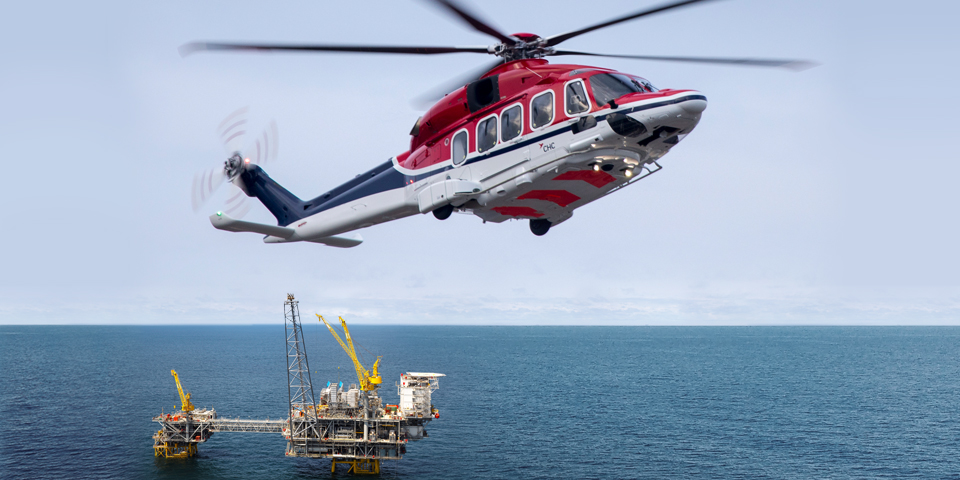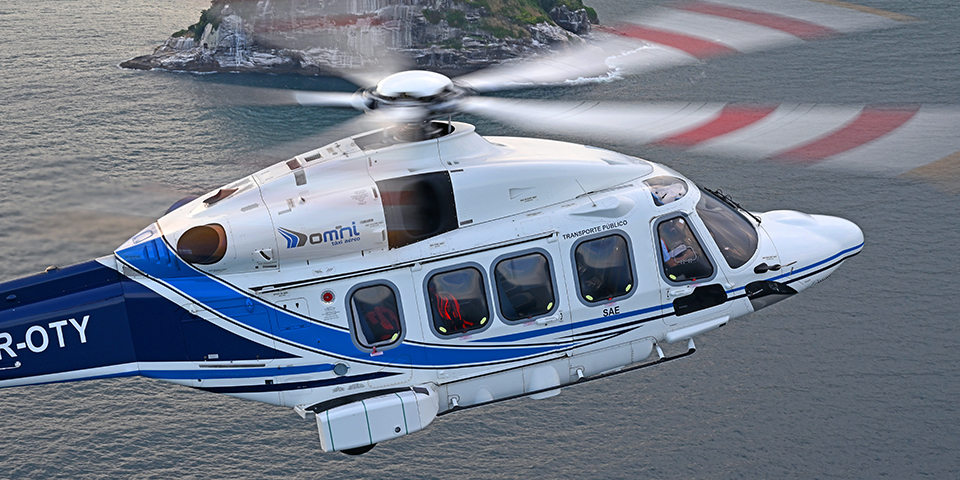For operators in the Energy sector, the offshore mission places unique demands on a helicopter – the ability to operate in harsh environments, exacting safety requirements and exceptional performance requirements. In recent years, the market’s focus has also turned increasingly to operational efficiency in the face of a tough economic climate.
Leonardo Helicopters has responded to these changing market requirements with a significant investment programme to ensure that the AW189 delivers class-leading efficiency, safety and reliability. These improvements have been developed in parallel with ongoing capability enhancements that position the AW189 as the benchmark in the super-medium category for all-weather offshore oil and gas, and renewable energy operations.
A proven platform
The AW189 has a proven pedigree in the offshore market. The global offshore fleet totals nearly 50 aircraft which together have amassed more than 114,000 flight hours in operations across six continents. Meanwhile, the worldwide Leonardo’s Super Medium fleet covering all applications now stands at nearly 115 aircraft operating in 22 countries.
Leonardo Helicopters is applying all the lessons learned from this wealth of operational experience into a wide-ranging efficiency programme as Andrea Bernascone, Product Marketing Lead for the AW189, explains: “In many ways the offshore market is ruled by efficiency and cost-effectiveness. This is the economic reality for operators today and so we have invested millions of euros in the last few years to drive efficiency improvements in every aspect of the AW189’s operations.

Reducing the maintenance burden
“For example, one key measure of efficiency is payload. Since 2018 we’ve worked on a weight reduction stream to increase payload and therefore reduce the cost per seat per mile. In particular, our efforts and investments led to the gain of almost a passenger more at the same radius of action (for example from 13 to 14 passengers at a 200 nm radius) further increasing the overall competitiveness.
“At the same time, working closely with engine manufacturer GE, we have been able to reduce fuel consumption by approximately 5% compared with the AW189’s entry into service fuel consumption figures. ‘Time on wing’ of the CT7 engines has also increased through concepts such as time-limited dispatch and on-condition maintenance, reducing the overall maintenance burden to improve aircraft availability.”
Bernascone also points to the AW189’s high service life limits and Time Between Overhauls (TBO). The TBO on the AW189’s Auxiliary Power Unit (APU) manufactured by Safran is now 12 years, for example, while the service life limit on the main rotor blades is 120,000 landings.
Equipped for the harshest environments
Harsh maritime environments increase the threat of corrosion and Leonardo Helicopters is leveraging the operational experience of the AW139 in particular since 2003, in which time it has accumulated millions of flight hours in demanding offshore and SAR missions, to ensure that the AW189 has class-leading corrosion protection.
Significant improvements in the production standard over recent years mean that the highest levels of corrosion protection are now embedded in the AW189 and across the AWFamily, which includes both the AW139 and AW169. Furthermore, the AW189’s high flight hours in some of the most demanding offshore environments in the world such as the North Sea and South East Asia underline the helicopter’s ability to perform in all environmental conditions without suffering corrosion issues.

Cold-weather operations
The AW189 has exceptional cold-weather operational capability, designed in from the earliest stage of the helicopter’s development. This starts with embedded design features such as heated air intakes and extends to the availability of two additional ‘layers’ of cold-weather protection systems in the form of the Limited Ice Protection System (LIPS) and Full Ice Protection System (FIPS).
Ice Protection is deployed extensively on the global AW189 offshore fleet, with 32 aircraft in service featuring either LIPS or FIPS protection – most of which are fitted with the more extensive FIPS capability that provides de-icing on the main rotor blades and anti-icing on the tail rotor blades.
Bernascone says that Leonardo Helicopters’ approach to certification for ice protection systems is a key differentiator in the market. “We undertook extensive icing campaigns in both artificial and natural icing conditions for the AW139 and AW189 to ensure the ice protection systems were proven in ‘real-world’ conditions. For the AW139, this meant a three-year campaign in the United States amassing 380 flight hours.
“Likewise, for the AW189, we conducted 340 hours of flight testing over three years with two prototypes, exposing them to a combination of artificial and natural icing conditions.”
Since certification of LIPS for the AW189 in 2015 and the subsequent FIPS certification and entry into service a year later, the AW189 has proven its cold-weather credentials with seven years of successful operation in cold-weather environments worldwide.
Advanced on-board technology
One of the characteristics of the AW189 is the open architecture avionics. Leonardo Helicopters owns all the software and most critical hardware components for the latest generation integrated avionics on board. “This has enabled us to respond and anticipate market requirements in a timely way,” explains Bernascone, “particularly in terms of the specific needs of the IOGP community for the offshore application.”
The AW189 provides crews with excellent situational awareness through advanced technologies such as a Synthetic Vision System and Vertical Situation Display to enhance flight crew awareness during arrival and approach operations.
The AW189 is also the first civil helicopter to integrate the Helicopter Terrain Awareness Warning System (HTAWS) offshore mode, making Leonardo Helicopters the only OEM to achieve this milestone to date. HTAWS offshore mode, through the adoption of CAP-1519 requirements, optimises warnings for pilots in commercial offshore operations. Along with the AW189’s Obstacle Proximity LiDAR System (OPLS), it enhances safety and protects against one of the leading causes of fatal accidents – Controlled Flight Into Terrain.
The helicopter’s Health and Usage Monitoring System (HUMS) allows early detection of critical failures and includes both on-ground data download and in-flight data transmission. EASA recently approved the new Helicopter Data Transmission which gives the ability to transmit data in real-time during flight to ground stations.
In addition, the AW189 complies with the latest Performance-Based Navigation standard (RNP 0.3) in all phases of flight, including authorisation required approach, Localiser Performance with Vertical Guidance (LPV) and automatic oil rig approach.

Final thoughts
The AW189 is optimised for the offshore mission, yet the helicopter’s inherent multi-role DNA means that its economics also add up for operators, not only in terms of operating cost but also when considering residual value, according to Bernascone. He concludes: “Efficiency and cost-effectiveness have been major areas of focus for us in the last few years because we know how important these priorities are to the operator community. The effort to make the AW189 even more efficient and capable will continue – our investment in this area never stops.”

